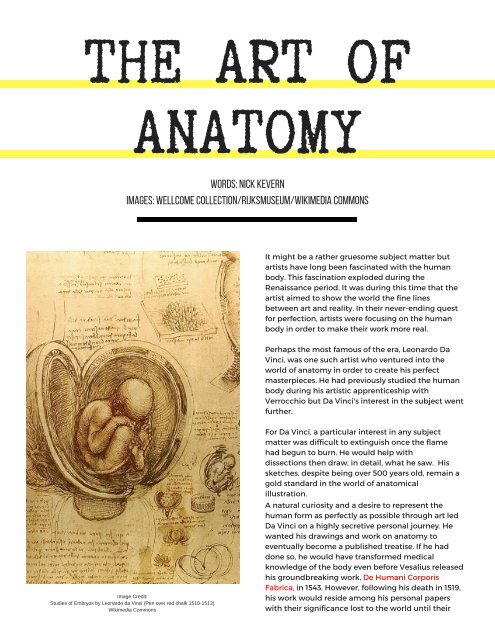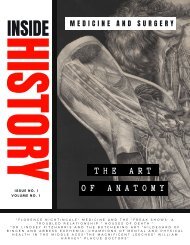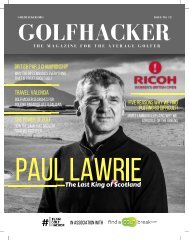InsideHistoryDigital
Create successful ePaper yourself
Turn your PDF publications into a flip-book with our unique Google optimized e-Paper software.
might be a rather gruesome subject matter but<br />
It<br />
have long been fascinated with the human<br />
artists<br />
This fascination exploded during the<br />
body.<br />
period. It was during this time that the<br />
Renaissance<br />
aimed to show the world the fine lines<br />
artist<br />
art and reality. In their never-ending quest<br />
between<br />
perfection, artists were focusing on the human<br />
for<br />
in order to make their work more real.<br />
body<br />
the most famous of the era, Leonardo Da<br />
Perhaps<br />
was one such artist who ventured into the<br />
Vinci,<br />
of anatomy in order to create his perfect<br />
world<br />
He had previously studied the human<br />
masterpieces.<br />
during his artistic apprenticeship with<br />
body<br />
but Da Vinci's interest in the subject went<br />
Verrocchio<br />
Da Vinci, a particular interest in any subject<br />
For<br />
was difficult to extinguish once the flame<br />
matter<br />
begun to burn. He would help with<br />
had<br />
then draw, in detail, what he saw. His<br />
dissections<br />
despite being over 500 years old, remain a<br />
sketches,<br />
standard in the world of anatomical<br />
gold<br />
natural curiosity and a desire to represent the<br />
A<br />
form as perfectly as possible through art led<br />
human<br />
Vinci on a highly secretive personal journey. He<br />
Da<br />
his drawings and work on anatomy to<br />
wanted<br />
become a published treatise. If he had<br />
eventually<br />
so, he would have transformed medical<br />
done<br />
of the body even before Vesalius released<br />
knowledge<br />
groundbreaking work, De Humani Corporis<br />
his<br />
work would reside among his personal papers<br />
his<br />
their significance lost to the world until their<br />
with<br />
THE ART OF<br />
ANATOMY<br />
Words: Nick Kevern<br />
Images: Wellcome Collection/Rijksmuseum/Wikimedia Commons<br />
further.<br />
illustration.<br />
Image Credit:<br />
Studies of Embryos by Leonardo da Vinci (Pen over red chalk 1510-1513)<br />
Wikimedia Commons<br />
Fabrica, in 1543. However, following his death in 1519,

















